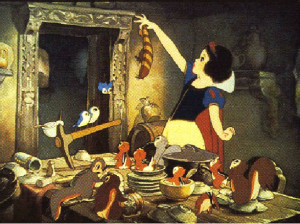Jim on Film
Page 2 of 7

Snow White and the Seven Dwarfs
(c) Disney
The Golden Age (1937-1942)
The aurora of excitement and experimentation is vividly thriving in these first
five films. The amount of care and detail is stunning, and in thinking of the
amount of time that was needed to complete these works, the viewer gets the
sense of what was happening at the studio during this time. Even though I am not
a visual artist, it is clear that the intricate detail of the clocks in
Gepetto’s shop were created with great love, as is the detailed woodwork inside
the Dwarf’s cottage, as well as the beauty of the snowflakes and flowers in
Fantasia, and the work in many other scenes from these pictures. Such
details flourish in these first films, more so than they would in later years,
and in watching them in sequence, this was much more apparent.
Knowing of the difficulty of some of the processes used at this time to achieve effects such as transparent shadows, realistic water, rouged cheeks, and naturally moving animals, the viewer can sense that these films bear the hearts and souls of the artists who created them. In fact, this amount of detail, heart, and love is almost overwhelming.
Take water, for example. For the first time, I noticed the amazing re-creation of water in Pinocchio. In the long shot of the cliff before Pinocchio and Jiminy Cricket dive into the ocean, there are waves rolling into the shore, and it looks like real water. Then, when they actually dive into the ocean, there’s a shot from above looking into the depths of the sea, and again, it is astonishingly beautiful. And these water shots appear many times in these early films, including in Dumbo, The Three Caballeros, and Make Mine Music.
One measure of this labor of love is in the development of animation of humans and animals. Whereas the humans in Snow White and the Seven Dwarfs are beautifully animated, their movements are not always as sharply defined as the animators would later perfect. The humans in Pinocchio just three years later, for example, are flawless, even the elegant Blue Fairy. Similarly, the animals in Snow White and the Seven Dwarfs are all beautifully animated, but when the style of a film called for more realistic animals, such as in Bambi, the animators greatly improved their craft to meet those needs.
As I was watching these films, I couldn’t help but draw a comparison. Before starting animation of the human characters in Snow White and the Seven Dwarfs, the artists, under the guidance of Walt Disney, were given the opportunity to learn and stretch their own talents to the point where the laughably ridiculous Persephone in the short The Goddess of Spring in 1934 would lead to the realistic and heartwarming Snow White in 1937. I think of this in comparison to the human characters animated using computers today and how unrealistically they move and function. Walt Disney knew what he wanted and didn’t settle for anything less than that. As a result, we have Snow White and the Seven Dwarfs, which lead to an entire canon of wonderful films.
The films from this era are all very unique. This is interesting considering how successful Snow White and the Seven Dwarfs was in comparison to Pinocchio, Fantasia, and Bambi. Disney must have felt some pressure, if not from audiences and critics then from his brother, to make sure one of these pictures made more money than it cost. In character design, story structure, genre, and even musical styles, Snow White and the Seven Dwarfs, Pinocchio, Fantasia, Dumbo, and Bambi are all very, very different from each other. It is clear that Disney had no intention of attempting to replicate elements from his earlier films.
Part of this is probably owed to the amazing creativity at work in the studio at this time, with strong leadership from Walt Disney. Each film is imagination incarnate. From the visual antics of Snow White’s forest friends to the amazing visuals in Fantasia, the level of this creativity and experimentation is frothing over in these films. Bambi¸ of course, is an excellent example of a story-based feature with that visual emphasis; it has a strong dependency on visuals rather than words to communicate to the audience. For example, when Bambi’s father sees man and calls for them to run deep into the forest, Bambi moves with him for one second, then stops, saying, “Faline.�? With that single word, his thoughts and intentions are clear. He doesn’t need to say, “Faline . . . I have to get Faline�? for us to understand.
